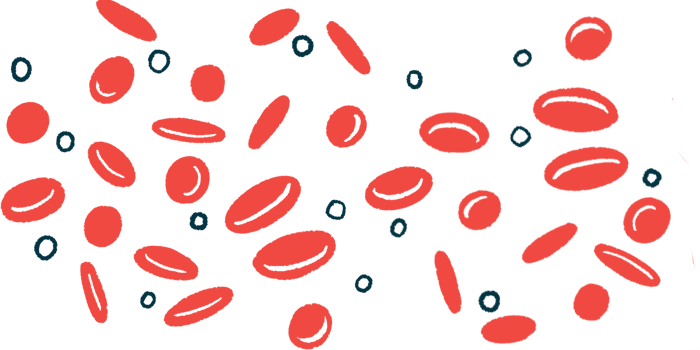2 Proteins That Silence Fetal Hemoglobin May Be Therapy Target

Interfering with two newly identified proteins — NFIA and NFIX — involved both directly and indirectly in silencing fetal hemoglobin in red blood cells, could be a new therapeutic approach for sickle cell disease (SCD), according to researchers.
Their hypothesis is that inhibiting the production or activity of these two proteins might help raise fetal hemoglobin levels in people with dysfunctional adult hemoglobin, such as those with SCD.
“Our study shows that transcription factors NFIA and NFIX have dual activity, both turning genes on and turning others off, the combined effect of which is the silencing of fetal hemoglobin,” Gerd A. Blobel, MD, PhD, an investigator at Children’s Hospital of Philadelphia (CHOP) and the study’s senior author, said in a press release.
“This research demonstrates how deeply complex the transition from fetal to adult hemoglobin is,” Blobel said. “But by better understanding the factors involved, future research could focus on exploiting these transcription factors as therapeutic targets.”
The study, “Dual function NFI factors control fetal hemoglobin silencing in adult erythroid cells,” was published in the journal Nature Genetics.
In sickle cell disease, mutations in the HBB gene lead to the production of a faulty version of adult hemoglobin, a protein in red blood cells that is responsible for carrying oxygen throughout the body.
But HBB is not turned on until after birth. In utero, a different set of genes, called HBG, are responsible for producing a fetal form of hemoglobin that is more efficient at transporting oxygen than its adult counterpart. After birth, HBG genes normally are turned off and HBB is activated.
In people with SCD, HBG genes are unaffected, and healthy fetal hemoglobin can be produced. A proposed approach to treating sickle cell disease, then, is to promote the production of healthy fetal hemoglobin during adulthood by “un-silencing” HBG.
But to do this effectively, scientists need to know more about the factors responsible for silencing HBG after birth.
Transcription factors are proteins that influence the transformation of information present in the DNA sequence of genes to RNA — the molecule that cells use as a template to make proteins. Some transcription factors enhance this transformation, while other repress it.
For example, the BCL11A and LRF transcription factors already have been found to play a role in silencing HBG1 and HBG2, preventing them from producing fetal hemoglobin.
Now, researchers in the U.S. performed a genetic screening to identify other transcription factors that might be involved in silencing HBG genes. The team, led by CHOP investigators, discovered that two members of the NF1 transcription factor family — NFIA and NFIX — acted to repress HBG1 and HBG2.
They found that NFIA and NFIX were present at higher levels in adult red blood cells compared with fetal ones. When NFIA function was disrupted, cells showed higher levels of HBG, more gamma globin — the part of fetal hemoglobin encoded by HBG — and more cells containing fetal hemoglobin altogether. When both NFIA and its family member, NFIX, were disrupted at the same time, these effects were even greater.
These findings were validated in mice transplanted with human red blood cells lacking the two transcription factors. After 16 weeks, or about four months, the donor cells showed marked increases in HBG levels. Additionally, the proportion of cells containing fetal hemoglobin rose from 8% to 67%.
Further genetic analyses showed that, in addition to suppressing fetal hemoglobin, NFIA and NFIX also suppressed other genes associated with a fetal-like state. Conversely, genes associated with adult cells, including HBB, were unaffected.
Overall, these findings suggest “a broader role for NFI factors in maintaining the adult cell fate,” the researchers wrote.
The team found that NFIA and NFIX influenced fetal hemoglobin levels through both direct and indirect mechanisms. A series of experiments revealed that the transcription factors were able to directly bind to HBG genes, where they influenced their activity levels.
But NFIA and NFIX also appeared to bind to DNA segments where the known HBG-repressor, BCL11A, also was active. Blocking NFIA and NFIX function lowered BCL11A levels by about 30%, suggesting these proteins may inhibit fetal hemoglobin through their relationship with BCL11A.
“Evidence supports a dual mechanism by which NFIA and NFIX act both directly on the HBG1/2 genes and indirectly by stimulating BCL11A transcription, producing a strong combinatorial effect,” the researchers wrote, adding that while each protein is necessary, “none of these are by themselves sufficient for keeping the HBG genes in a completely repressed state.”
Importantly, in cells derived from SCD patients, disrupting NFIA and NIFX also prevented the formation of sickled, or misshapen red blood cells characteristic of the disease, by more than 70%.
“Disruption of NFIA and NFIX genes or inhibiting their transcriptional activities might be beneficial for [beta]-globin disorders [i.e. SCD],” the researchers wrote.
They also noted that since red blood cell function was largely preserved in the absence of the transcription factors, interfering with their activity might be well-tolerated in patients.







